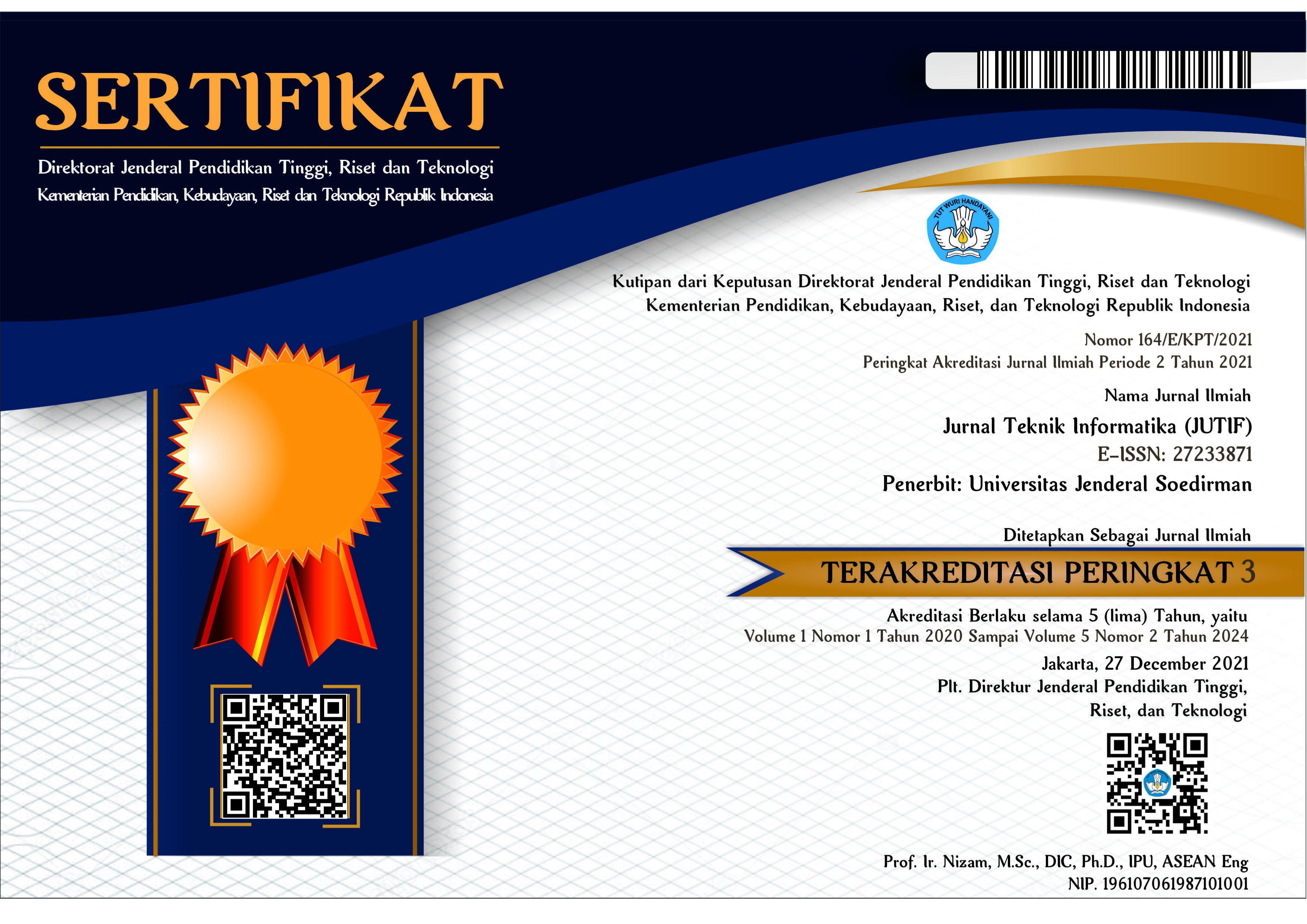SENTIMENT ANALYSIS OF INDONESIAN ELECTION 2024 USING THE K-NEAREST NEIGHBOR METHOD
DOI:
https://doi.org/10.52436/1.jutif.2024.5.2.1934Keywords:
Sentiment Analysis, K-Nearest Neighbor, 2024 Election, Presidential Election, TwitterAbstract
The abstract of this research discusses the analysis of Indonesian public sentiment regarding the 2024 election as observed via Twitter. Sentiment graph Research uses the Natural Language Processing method and the K-Nearest Neighbor algorithm to classify sentiment as positive, neutral, or negative. The current era of globalization influences the rapid progress of information technology circulating in society, one of the intermediaries is through the social media Twitter. Twitter can be used as a means of conveying opinions regarding suggestions, criticism and public opinion. Currently social media has a big impact on building public political sentiment and preferences. The social media I took is Twitter so that people's Tweets related to elections can be used to see a picture of public opinion. There are various opinions of Twitter users with positive, neutral and negative sentiments. However, classifying sentiment from Twitter users requires quite a lot of time and effort due to the large number of tweets found. The aim of this research is to conduct a public sentiment analysis of public opinion regarding the 2024 election. Data was collected in October and December 2023. The results show that positive sentiment dominates with 76%, followed by neutral sentiment at 16%, and negative 6%. This analysis helps understand public opinion regarding the 2024 election on social media, especially Twitter.
Downloads
References
P. D. Tommy, U. Ema, P. M. Kurniawan. “Analisis Sentimen Pemilu 2024 dengan Naive Bayes Berbasis Particle Swarm Optimization (PSO)”. EXPLORE – Volume 13 No 1 Tahun 2023 p-ISSN : 2087- 894X e-ISSN : 2656-615X.
F. P. Midhat, “Perbandingan Algoritma K-Nearest Neighbor (KNN) dan Naive Bayes Classifier (NBC) dengan pelabelan Transformers serta Ekstrasi Fitur TF-IDF dan N-Gram untuk Analasisis Sentimen Terhadap Penundaan Pemilu 2024”.
N. P. Aprilia, H. L. April, H. S. Shofa, Tukino, P. Bayu. “Analisis Sentimen Calon Presiden 2024 Menggunakan Algoritma SVM Pada Media Sosial Twitter”. JOINTECS, Vol. 8 No. 1, pp. 11 - 18, 2023, e-ISSN:2541-6448 p- ISSN:2541-3619, http://publishing-widyagama.ac.id/ejournal- v2/index.php/jointecs.https://kab-minahasaselatan.kpu.go.id/page/read/34/pe milu-tahun 1955#:~:text=Pemilu%20ini%20diikuti%20 oleh%20lebih,daftar%20kumpulan%20dan%20calon%20perorangan
D. A. Dwi, K. L. Kristoforus. “EFEKTIVITAS PEMILIHAN UMUM SERENTAK TAHUN 2024”. JHP 17 (Jurnal Hasil Penelitian), Vol. 8, No. 2, Juli 2023, E-ISSN: 2502-8308 P-ISSN: 2579- 7980, http://jurnal.untag- sby.ac.id/index.php/jhp17
A. Muhammad, S. Mohammad. “ANALISIS SENTIMEN ANIES BASWEDAN MENJADI CALON PRESIDEN 2024 MENGGUNAKAN KSTRASI FITUR COUNTVERCTORIZER DAN ALGORITMA KNN”, Seminar Nasional Mahasiswa Fakultas Teknologi Informasi (SENAFTI), Vol. 2, No. 2, September 2023, ISSN 2962-8628 (online)
Z. H. Haekal, A. M. Rolly, R. I. Woro. “Perbandingan Model Svm, Knn Dan Naïve Bayes Untuk Analisis Sentiment Pada Data Twitter: Studi Kasus Calon Presiden 2024”. JIMPS: Jurnal Ilmiah Mahasiswa Pendidikan Sejarah, Vol. 8, No. 3, pp. 2083-2093, 2023. P-ISSN: 2964-7231, E-ISSN 2614-3658 DOI: https://doi.org/10.24815/jimps.v8i3.25342
A. A. Firdaus, A. Yudhana, I. Riadi, “ANALISIS SENTIMEN PADA PROYEKSI PEMILIHAN PRESIDEN 2024 MENGGUNAKAN METODE SUPPORT VECTOR MACHINE”, DECODE: Jurnal Pendidikan Teknologi Informasi, Vol. 3, No. 2, pp. 236-245, September 2023, ISSN Cetak: 2775-2984 ISSN Online: 2775-1813, Doi: http://dx.doi.org/10.51454/decode.v3i2.172 http://journal.umkendari.ac.id/index.php/de code.
M. Oktaviani, P. Cahyo, H. H. N. Harani. “Analisis Sentimen Untuk Memprediksi Hasil Calon Pemilu Presiden Menggunakan Lexicon Based dan Random Forest”. JURNAL ILMIAH INFORMATIK, Vol. 11 No.02, 2023, ISSN (Print) 2337-8379 | ISSN (Online) 2615-1049.
T. J. Asahar, Y. Delfi, A. Kurnia. “IMPLEMENTASI METODE K- NEAREST NEIGHBOR (KNN) DAN SIMPLE ADDITIVE WEIGHTING (SAW) DALAM PENGAMBILAN KEPUTUSAN SELEKSI PENERIMAAN ANGGOTA PASKIBRAKA”, Jurnal Pseudocode, Vol. 3, No. 2, September 2016, ISSN 2355-5920.
P. A. Rizki, P. Wahyu, “PENERAPAN ALGORITMA K- NEAREST NEIGHBOR (KNN) ANALISIS SENTIMEN TWEET PADA ELEKTABILITAS BAKAL CALON PRESIDEN 2024”. 3rdSeminar Nasional Mahasiswa Fakultas Teknologi Informasi (SENAFTI), Vol. 2, No. 2, September 2023, ISSN 2962-8628 (online)
I. A. Muhammad, “PENINGKATAN AKURASI ALGORITMA K-NEAREST NEIGHBOR MENGGUNAKAN NORMALISASI Z-SCORE DAN PARTICLE SWARM OPTIMIZATION UNTUK PREDIKSI CUSTOMER CHURN”.
S. R. Aris. “Analisis Sentimen Pada Media Sosial Menggunakan Metode K- Nearest Neighbor (K-NN)”, Teknologipintar.org, Vol. 2, No. 8, 2022.
Z. H. Farhan, “IMPLEMENTASI ALGORITMA KNN DALAM MENGUKUR KETEPATAN KELULUSAN MAHASISWA UIN SYARIF HIDAYATULLAH JAKARTA”.
S. Retno, “Analisis Sentimen Pada Review Objek Wisata Dunia Fantasi menggunakan Algoritma K-Nearest Neighbor (K-NN)”. Evolusi: Jurnal Sains dan Manajemen, Vol 8 No. 1, Maret 2020, ISSN:2338-8161 E-ISSN: 2657-0793.
J. Muliawan and E. Dazki, “SENTIMENT ANALYSIS OF INDONESIA’S CAPITAL CITY RELOCATION USING THREE ALGORITHMS: NAÏVE BAYES, KNN, AND RANDOM FOREST,” Jurnal Teknik Informatika (JUTIF), vol. 4, no. 5, pp. 1227–1236, 2023, doi: 10.52436/1.jutif.2023.4.5.347.




























